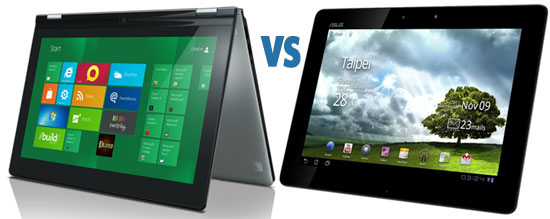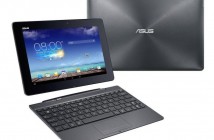
We’ve seen quite a few great devices at CES 2012, but one of the most active areas was the tablet niche: there were a lot of new tablets, most of them running Android, some of them running Windows, and some running a special version of Linux.
The first two operating systems are more interesting though, and the most advanced tablets that represented each of them were the Asus Transformer Prime 700 series for Android and the Lenovo IdeaPad Yoga for Windows. Granted, these two tablet/laptop hybrids are aimed at two different markets, but they also have a lot of similarities that make a comparison all but inevitable.
Exterior design
You might already know that the Transformer Prime was the first tablet to sport a quad core processor (the new Tegra 3 from NVidia), and it’s already on sale for a very nice price. Well, the Transformer Prime 700 (aka TF700) brings a few improvements to the table and aims to perfect the model. On the other side, we’ve got the IdeaPad Yoga – one of the most unique Windows tablets to date.
Both devices look pretty nice, however the Prime has a more conventional design – it’s a simple slate, with the keyboard dock being optional and detachable. The IdeaPad Yoga looks like an ordinary Ultrabook when you first open it up, however you may soon find that its display extends far beyond 180 degrees and transforms the laptop into a full-fledged tablet. That’s the most interesting design I’ve seen for a convertible tablet, ever.
Hardware features
Both the IdeaPad Yoga and the Transformer Prime 700 are intended to be used as a multi-purpose computer, but the internal hardware is quite different in each case. The Transformer Prime has a 10.1 inch IPS display with a 1920×1200 Full HD resolution that looks very crisp and clear. It also features all the normal stuff that an Android tablet (especially a flagship model) should have: Wifi N and Bluetooth adapters, GPS, a nice 8 megapixels camera on the back with support for 1080p video recording and a 1.3 megapixels snapper on the front for video calls, USB and HDMI out ports, two speakers for stereo sound, a 3.5 mm audio jack, and more.
The IdeaPad Yoga is twice as heavy and almost twice as big as the TF700, but it packs a 13.3 inch display with a 1600×900 pixels resolution (lower than a 10 inch Android device – weird, right?) and a full keyboard on the housing. There is only a small 2 megapixels camera for video calls and photos, and the ports selection is a bit better, although not by much – the tablet has two USB ports, a HDMI port, as well as a 3.5 mm audio jack. The Wifi and Bluetooth adapters are there, but the GPS is missing. It’s a bit unfair to compare these two tablets, but if Lenovo wants the Yoga to be the ultimate tablet/Ultrabook hybrid and compete with Android, they could’ve done better in the features department.
Performance
Here’s where the IdeaPad Yoga shines, but only in specialized apps that are not available for Android. Being an x86 device, the Yoga can run all the applications and software that Windows has, which is impressive indeed. The Ivy Bridge ULV processor, 4-8 GB of RAM and a 128 or 256 GB SSD drive are also great and definitely beat the quad core Tegra 3 + 1 GB of RAM + 32 or 64 GB of storage space on the Transformer Prime 700.
However, in everyday use, the experience will be pretty much the same and maybe even in favor of the Android tablet – at least that’s the impression you get when seeing the lag in the current developer preview version of Windows 8.
Software
Speaking of which, Windows 8 isn’t even ready for prime time, and is slated to arrive sometime at the end of this summer, which means that the TF700 will reign on the tablet market for quite a while. Android Ice Cream Sandwich is a great OS, and with over 300,000 apps on the marketplace, it can do pretty much everything a normal user would want to.
The Asus Transformer Prime 700 series is twice as cheap as the IdeaPad Yoga, and that’s counting the keyboard dock, of course. It can make a perfect universal computer and laptop/desktop replacement for anyone, but if you really need the ability to run Windows apps, waiting for the Yoga could be worth it as it is the best Windows tablet yet.



1 Comment
Gosh don’t know which is best, but I hear the Asus Transformer is pretty bang up good!